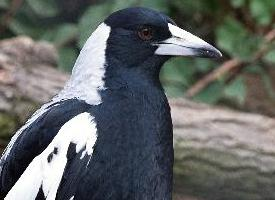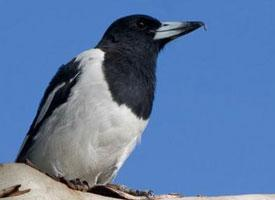
Description de l'animal
The Australian magpie (Gymnorhina tibicen) is a medium-sized passerine bird native to Australia and southern New Guinea. It is one of the most recognizable and iconic birds in Australia, both for its striking appearance and its complex, melodious song. The Australian magpie is not closely related to the European magpie, which is a member of the Corvidae family; instead, it belongs to the Artamidae family, which also includes butcherbirds and woodswallows.Physical Description:
The Australian magpie is a robust bird with a length of about 37 to 43 centimeters (14.5 to 17 inches) and a wingspan that can reach up to 65 centimeters (26 inches). Its plumage is a striking contrast of black and white. The back and wings are black with white shoulders and the underparts are white. The head is black, with a distinctive white nape and a white patch on the back of the head. Juveniles have greyer or browner plumage, which gradually becomes more defined in black and white as they mature.
The magpie's bill is stout and bluish-white with a black tip. It is slightly hooked at the end, making it well-suited for foraging on the ground and capable of tackling a variety of prey. Their eyes are reddish-brown to dark brown, and their legs and feet are black, strong, and adapted for walking on the ground.
Behavior and Diet:
Australian magpies are highly intelligent and social birds. They live in groups called 'tribes' or 'flutes' which have a complex social structure and maintain territories that they defend vigorously. They are predominantly ground feeders and forage on the ground in open areas such as lawns, parks, and pastures. Their diet is varied and omnivorous, consisting of insects, rodents, small reptiles, seeds, and occasionally, carrion. They use their sharp bills to probe the soil and can catch fast-moving prey such as beetles and worms.
Vocalizations:
One of the most remarkable features of the Australian magpie is its vocal ability. The bird is known for its beautiful and varied song, which includes a range of melodious fluting notes, mimicry of other birds, and even human-made sounds. Magpies are often heard singing at dawn and dusk, and their caroling is considered one of the quintessential sounds of the Australian bush. The song is not only a means of communication but also plays a role in territorial defense and social bonding.
Breeding:
Australian magpies breed from August to October. They build their nests high up in trees, often 15 meters above the ground. The nest is a bowl-shaped structure made from sticks and twigs, lined with grass and other soft materials. The female typically lays three to five blue or greenish eggs with brown spots. Both parents share incubation duties and care for the young. The chicks are born blind and featherless but grow rapidly and are ready to leave the nest after about four weeks.
Interaction with Humans:
Australian magpies have adapted well to human-altered environments and can often be seen in urban and suburban areas. While they are generally not aggressive, during the breeding season, some magpies may swoop at humans who come too close to their nests, a behavior known as 'swooping.' This defensive action is intended to protect their young, and while it can be intimidating, it is usually harmless. People have developed various strategies to avoid swooping, such as wearing hats or carrying umbrellas during the breeding season.
Conservation Status:
The Australian magpie is currently not considered to be at risk. It has a large range and a stable population size. Due to its adaptability to various habitats, including those modified by humans, the magpie is a common and familiar sight across much of its range. However, like all wildlife, it faces challenges from habitat destruction and changes to the natural environment, so conservation efforts remain important to ensure the species continues to thrive.
Animaux similaires
Nouvelles photos d'animaux
Top 10 des animaux
- Dolphin gull (Leucophaeus scoresbii)
- Diana monkey (Cercopithecus diana)
- Moustached guenon (Cercopithecus cephus)
- Galápagos tortoise (Geochelone nigra complex)
- Russian tortoise (Testudo horsfieldii)
- Japanese macaque (Macaca fuscata)
- Stone loach (Barbatula barbatula)
- Common flying dragon (Draco volans)
- Greek tortoise (Testudo graeca)
- Vendace (Coregonus albula)
